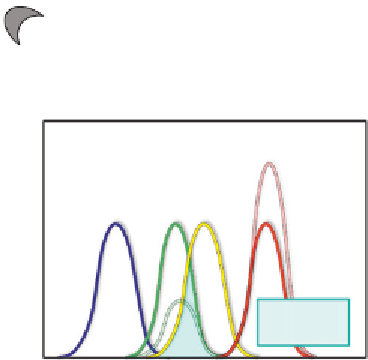Biology Reference
In-Depth Information
A
Ex
donor
Em
donor
Ex
donor
Em
acceptor
Probe
Donor
Acceptor
Interaction
B
Donor
Acceptor
FRET
Ex
Em
Ex
Em
Spectral
Spectral
overlap
overlap
Wavelength (nm)
Figure 4.4 Förster resonance energy transfer (FRET) principle. (A) When two molecules
with appropriate donor and acceptor fluorophores interact, FRET occurs between the
donor in the excited state and the acceptor in the ground state. (B) When the donor
is excited at its absorption spectrum (blue), it typically emits at a shorter wavelength
(green) that overlaps with the absorption spectrum of the donor (yellow). Then the
resulting FRET enables the acceptor to emit fluorescence (red).
specific acceptor/donor couple to associate with interacting partners can
constitute a powerful tool to demonstrate both dynamic and
in situ
interac-
tions as well as conformational changes.
1.2.3 Fluorescence polarization
Fluorescence Polarization was first described in 1926 by Perrin.
14
This
specific type of polarization is based on the observation that fluorescent
molecules in solution, excited with plane-polarized light, will emit light
back in a fixed plane if the molecules remain stationary during the excita-
tion of the fluorophore; the emitted light remains “polarized.” However,
molecules rotate and tumble, and the planes in which light is emitted can
be very different from the plane used for initial excitation; the emitted light


























Search WWH ::

Custom Search